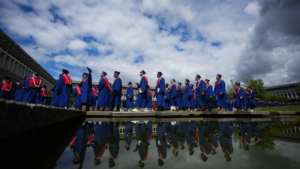
CANADA
Canada’s Immigration Minister, Marc Miller, has confirmed that the cap on international students “is here to stay.” Immigration, Refugees, and Citizenship Canada (IRCC) will issue a maximum of 437,000 study permits in 2025. This figure represents a 10% reduction from the 2024 target of 485,000 permits, with plans to maintain this intake limit through 2026.
Table of Contents
As a result, IRCC estimates that approximately 300,000 fewer study permits will be issued to international students over the next several years.
Canada’s Immigration Minister, Marc Miller, has announced a series of significant changes to the country’s international student program, stating that “the international student cap is here to stay.”
Immigration, Refugees, and Citizenship Canada (IRCC) will limit the issuance of study permits to 437,000 in 2025. This number represents a 10% reduction from the 2024 target of 485,000 permits, with plans to maintain this cap through 2026. According to IRCC, this adjustment will result in 300,000 fewer study permits being granted over the next few years.
Miller emphasized that not everyone who wants to come to Canada will be able to, nor will everyone who wishes to stay. “Our immigration system must preserve its integrity and be well-managed and sustainable. We will do everything necessary to achieve that goal and ensure newcomers’ success,” he said.
New Requirements for Master’s and PhD Students
For the first time, master’s and PhD students will be included under the updated study permit cap and will now be required to obtain a Provincial Attestation Letter (PAL). The government has reserved approximately 12% of study permit allocations for these students, recognizing their positive contributions to the Canadian labor market. PALs were introduced earlier this year for college and undergraduate students to help verify the authenticity of their applications and manage the number of study permits issued.

Changes to PGWP Eligibility
Further modifications have been made to the eligibility criteria for the Post-Graduation Work Permit (PGWP). Starting November 1, university graduates will need to achieve a Canadian Language Benchmark (CLB) score of 7, while college graduates will require a CLB of 5 to qualify. The government anticipates that this change will result in 175,000 fewer PGWPs being issued over the next three years.
Restrictions on Spousal Open Work Permits
IRCC is also tightening eligibility for Spousal Open Work Permits. Beginning later this year, only spouses of master’s degree students enrolled in programs lasting at least 16 months will be eligible. This measure is expected to reduce the number of spousal work permits by 50,000 over the next three years. Additionally, Spousal Open Work Permits for those unrelated to the student program will be limited to spouses of Canadians or permanent residents working in critical sectors.
Impact on the Temporary Foreign Worker Program (TFWP)
The changes come as Canada’s unemployment rate has steadily risen, increasing from 6.4% in April 2023 to 6.6% in August 2024. With 1.5 million unemployed people in the country, the government is taking steps to reduce the number of temporary residents on work permits.
Minister of Employment, Workforce Development, and Official Languages, Randy Boissonnault, echoed Miller’s remarks, stating that the Temporary Foreign Worker Program (TFWP) should be used only as a last resort and not as a way to replace Canadian workers or suppress wages. However, he also noted that immigration contributes to 99% of Canada’s economic growth, a figure expected to reach 100% by 2032.

Broader Immigration Reforms
These announcements are part of a broader overhaul of Canada’s immigration system in 2024. In January, IRCC implemented the first-ever cap on study permits, initially set as a temporary policy through 2025. This cap also introduced the PAL system, which was paired with tighter PGWP eligibility and spousal work permit restrictions.
In March, Miller announced that the Immigration Levels Plan for 2025-2027 will, for the first time, include temporary resident levels as part of an effort to decrease the number of temporary residents, particularly those on study or work permits. Other steps include:
- Ending the COVID-era policy allowing visitors to apply for job-supported work permits from within Canada;
- Pausing the processing of Labour Market Impact Assessments (LMIAs) for low-wage TFWP jobs in regions with unemployment rates of 6% or higher; and
- Considering significant changes to PGWP issuance, potentially linking permits to educational programs in high-demand sectors of the economy.
Miller has also indicated that he is open to addressing permanent immigration levels but cautioned against “overcorrecting,” noting that any adjustments would be “significant” rather than “cosmetic.” More updates on this front are expected soon.
FOR MORE INFORMATION CLICK ON : https://esseindiacomplaints.com/
![]()





